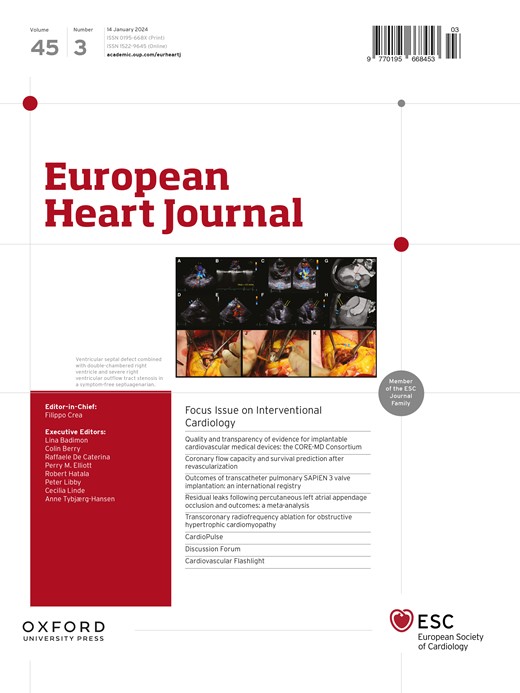心血管疾病中内皮细胞向间充质细胞的转变:分子见解和临床观点。
IF 35.6
1区 医学
Q1 CARDIAC & CARDIOVASCULAR SYSTEMS
引用次数: 0
摘要
内皮细胞向间充质转化(EndMT)是内皮细胞向间充质样转变的过程,如成为平滑肌细胞、成骨细胞、成纤维细胞或软骨细胞。在胚胎心脏发育中,EndMT的重要性在几十年前就已经确立,内皮细胞接受EndMT形成心内膜垫,最终发育成心脏瓣膜。最近,在各种成人心血管疾病中也观察到EndMT。这是通过应用最先进的研究工具建立的,包括小鼠细胞谱系追踪和单细胞RNA测序,这些工具可以深入分析内皮细胞向间充质样状态的转变。与任何新兴领域一样,也出现了一些挑战,例如缺乏在分子水平上构成EndMT的标准化定义,以及在人类中获得EndMT参与心血管疾病病理生理学机制的证据。在移植血管病变、肺动脉高压、静脉移植物重塑、动脉粥样硬化和瓣膜性心脏病中,存在成年人中发生EndMT的细胞的最大证据。转化生长因子β途径是主要的驱动因素,但这并不是控制这一复杂过程的唯一信号机制。在瓣膜性心脏病和静脉移植物重塑中,已经进行了大型动物转化研究,以抑制EndMT,并取得了积极的结果。这些研究为首次在人类临床中抑制EndMT作为治疗策略铺平了道路。在这里,我们回顾了这一令人兴奋的领域,特别强调EndMT在成人心血管疾病中的功能作用,并以动脉粥样硬化和瓣膜疾病为例。本文章由计算机程序翻译,如有差异,请以英文原文为准。
Endothelial to mesenchymal transition in cardiovascular diseases: molecular insights and clinical perspectives.
Endothelial to mesenchymal transition (EndMT) is a process whereby endothelial cells transition to adopt a mesenchymal-like fate, e.g. to become smooth muscle cells, osteoblasts, fibroblasts, or chondrocytes. In embryonic heart development, the importance of EndMT was established several decades ago, with ECs undergoing EndMT to give rise to the endocardial cushions that ultimately develop into the cardiac valves. More recently, EndMT has been observed in various adult cardiovascular diseases. This has been established through the application of state-of-the-art research tools, including cell lineage tracing in mice and single cell RNA sequencing, which have allowed in depth profiling of endothelial cells that have undergone transition to a mesenchymal-like state. As with any emerging field, certain challenges have arisen, such as the lack of a standardized definition of what constitutes EndMT at a molecular level and obtaining proof in humans that EndMT is mechanistically involved in the pathophysiology of cardiovascular diseases. The greatest evidence for the presence of cells undergoing EndMT in the adult exists for transplant vasculopathy, pulmonary arterial hypertension, vein graft remodeling, atherosclerosis, and valvular heart disease. The transforming growth factor beta pathway is the major driver, but this is not the exclusive signalling mechanism governing this complex process. Translational large animal studies have already been undertaken to inhibit EndMT in both valvular heart disease and vein graft remodeling, with positive results. These studies pave the way towards first-in-human clinical inhibition of EndMT as a therapeutic strategy. Here we review this exciting field, with particular emphasis on the functional role of EndMT in adult cardiovascular diseases using atherosclerosis and valvular disease as exemplars.
求助全文
通过发布文献求助,成功后即可免费获取论文全文。
去求助
来源期刊

European Heart Journal
医学-心血管系统
CiteScore
39.30
自引率
6.90%
发文量
3942
审稿时长
1 months
期刊介绍:
The European Heart Journal is a renowned international journal that focuses on cardiovascular medicine. It is published weekly and is the official journal of the European Society of Cardiology. This peer-reviewed journal is committed to publishing high-quality clinical and scientific material pertaining to all aspects of cardiovascular medicine. It covers a diverse range of topics including research findings, technical evaluations, and reviews. Moreover, the journal serves as a platform for the exchange of information and discussions on various aspects of cardiovascular medicine, including educational matters.
In addition to original papers on cardiovascular medicine and surgery, the European Heart Journal also presents reviews, clinical perspectives, ESC Guidelines, and editorial articles that highlight recent advancements in cardiology. Additionally, the journal actively encourages readers to share their thoughts and opinions through correspondence.
 求助内容:
求助内容: 应助结果提醒方式:
应助结果提醒方式:


